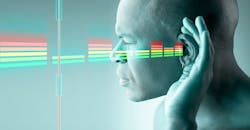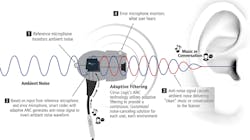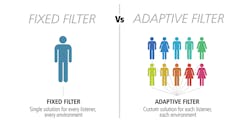What’s the Difference Between Passive and Active Noise Cancellation?
Download this article in PDF format.
The term “noise cancellation” embodies a number of different approaches to eliminating unwanted outside noise in order to enhance the listening experience. With so many terms, such as active noise cancellation, passive noise cancellation, and total noise cancellation, it can get confusing for an end user or system developer to determine the ideal noise-cancellation technology.
As the use of smartphones, digital assistants, and other devices for music playback move further into the mainstream, audio features like noise cancellation become more important to help ensure higher-quality audio playback and phone calls. With OEMs looking for new ways to differentiate their products and appeal to the discerning consumer, digital headsets that offer compelling noise-cancellation technology stand ready to capitalize.
In simple terms, active noise cancelling (ANC) headphones are designed to actively block out external noise. They use a microphone to pick up on environmental noise and then generate a sound wave that cancels it out. ANC headphones are great for use in noisy environments, such as on an airplane or in a city.
Passive noise cancelling headphones do not actively block out noise. However, they are typically designed with thicker ear cups that create a seal around the ear, which can help to reduce the amount of environmental noise that is heard. Passive noise cancelling headphones are not as effective as active noise cancelling headphones in terms of noise reduction, but they can still be helpful in reducing the amount of noise that is heard.
This overview will highlight the differences between passive, active, and total noise cancellation, as well as compare the different noise-cancellation architectures including feed-forward, feedback, and hybrid. It will also contrast fixed filters versus the more progressive adaptive noise-cancellation approaches.
Passive Noise Cancellation
Passive noise cancellation is what the headset itself offers, whether rubber tips in an in-ear design or padding in an over-the-ear design. Very simply, it’s the amount of noise cancellation offered by the physical device, or how well the headset works as an earplug. While a good design will provide strong passive cancellation before electronics are applied, passive cancellation is often limited to cancelling frequencies above 1 kHz. Even the best active electronics can’t compensate for poor acoustic design with minimal passive cancellation.
Active Noise Cancellation
Active noise cancellation (ANC) is the process of using a microphone to monitor environmental noise and creating anti-noise that’s then mixed in with audio playback to cancel noise entering the user’s ear. Active noise cancellation can be achieved with analog filters or digital filters, and is generally differentiated by architecture: feed-forward cancellation, feedback cancellation or hybrid cancellation. As mentioned, great active cancellation will significantly improve a headset with good passive cancellation, but can’t make up for poor design.
Total Cancellation
Total cancellation—the noise-cancelling effect heard by the end user—is simply a measure of passive cancellation plus active cancellation. The ability of the active electronics and the acoustic design acting together will determine the total cancellation that defines the quality of noise cancellation experienced by the user.
Feed-Forward/Feedback
As mentioned above, there are three types of ANC architectures: feed-forward, feedback, and hybrid (a combination of feed-forward plus feedback.) Feed-forward ANC uses a reference microphone outside the headset that monitors external noise, inverts it into “anti-noise,” then mixes it with audio playback to create noise cancellation. This process is actually quite complex, as the inversion must take into account the path traveled by the actual noise, then calculate the anti-noise signal to be faster than the time it takes for the noise to go from the microphone to the eardrum.
Feedback ANC presents challenges, because it can be difficult to design a feedback system that’s always stable due to variations in the fit across different human ears and the tendency for the feedback loop to destabilize the system. Feedback requires a microphone on the inside of the headset that monitors the sound going to the user’s ear. By comparing the sound in the user’s ear to the audio source, the feedback algorithm can identify the noise and create anti-noise to help cancel it out.
Because the round-trip time, which includes monitoring, comparing, and creating anti-noise, is longer than that for feed-forward anti-noise, feedback is only effective at cancelling low-frequency noise. A challenge with feedback ANC is that since the playback is being monitored, there’s a risk that part of the playback signal will be seen as noise and cancelled. This causes coloration, or distortion, from the original signal.
Hybrid Feed-Forward/Feedback
A hybrid feed-forward/feedback ANC solution can offer the best of both worlds, using an external reference microphone to monitor environmental noise, as well as an internal error microphone to monitor what the user hears beyond audio playback. When feed-forward is combined with feedback, the user should receive the best noise cancellation.
Fixed vs. Adaptive Filters
Until recently, only static fixed-filter ANC solutions were available. Fixed filters work, but this one-size-fits-all method dictates that one filter is used for all listeners. To improve this approach, newer adaptive ANC solutions can actually change according to a person’s ear size or headset fit and adapt to a changing environment. This improves the noise cancellation experience across a broader number of users.
For example, in one ANC solution developed by Cirrus Logic, noise-cancellation filters can be adjusted tens of thousands of times per second. Coupled with low anti-noise latency, a system designer is able to develop a compelling noise-cancelling headset and provide a broader bandwidth of noise-cancelling potential.
Adaptation also goes beyond fit. If you think about the environment, there are many different types of noise: airplane (low frequency), café (mid frequency), concerts (very loud), and library (very quiet). For each situation, adaptive filters can maximize the total energy cancellation for the specific environment. That is, in an airplane, the filters cancel more low frequency; in a café, they handle the mid frequencies, and so forth. This is a simple summary of a complex process, but it offers insight into the power of adaptive filters.
Advantages of Adaptive vs. Fixed Noise Cancellation
One challenge of developing a superior noise-cancellation solution is accommodating the thousands of different ear sizes for the thousands of different users. While the simple model of active noise cancellation describes inverting the noise, as mentioned previously, the reality is that anti-noise generation must consider the path from the reference microphone to the eardrum. If the ANC system doesn’t model the noise path correctly, the anti-noise produced may not be accurate and could even boost noise.
This is a possible problematic result of one-size-fits-all fixed filters. An adaptive filter uses an error microphone to more accurately model what’s actually heard by a user. In this way, the system can then adapt or compensate the filters to make sure that any anti-noise produced is appropriate for the user at hand.
An advantage of adaptive-filter over fixed-filter solutions is that with adaptive filters, each individual user has a customized solution, or better noise cancellation that accounts for each individual’s unique physical characteristics. In addition, an adaptive solution can monitor the actual noise and adjust filters, based on noise type, to maximize cancellation.
In the past, only sealed earbuds or over-the-ear headsets could be designed with fixed filters for noise cancellation. Today, leaky or unsealed earbuds can utilize adaptive noise cancellation, since the algorithm can compensate for the variable fit of a leaky solution. Adaptive solutions also sound better, because they remove coloration inherent in feedback ANC. In the end, with adaptive noise cancellation, you will not only know there’s a difference—you’ll be able to hear the difference.
Conclusion
The future of noise cancellation technologies is promising. Active noise cancellation (ANC) technology is constantly improving, and new passive noise cancellation technologies are being developed. ANC technology is becoming more effective and efficient, and new passive noise cancellation technologies are making it possible to cancel out a wider range of frequencies. ANC and PNC technologies are also likely to be combined for maximum cancelation and clarity. For example, PNC could be used to block out low-frequency noise, while ANC could be used to cancel out higher-frequency noise. ANC and PNC could also be used together to create a “quiet zone” around a person or object.
About the Author
Derek Phillips
Product Line Manager
Derek Phillips is product line manager for Cirrus Logic, where he is responsible for the company’s active noise-cancellation (ANC) solutions. With an applications engineering and systems architecture background, Phillips brings more than 20 years of industry experience to his product marketing role. He held engineering and marketing positions at Freescale, Sigmatel, AMD, and Alchemy Technologies prior to rejoining Cirrus Logic in 2013.



